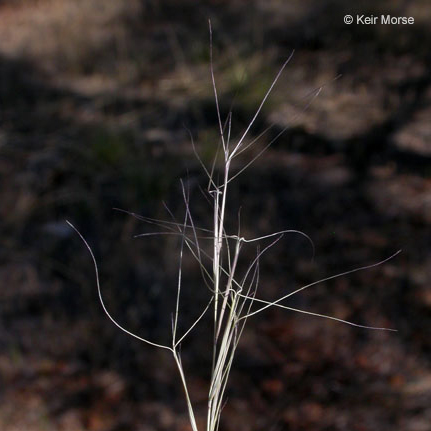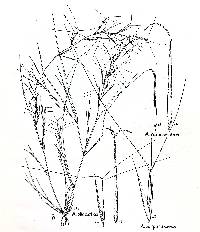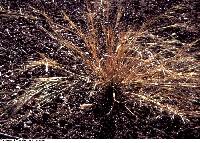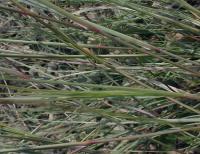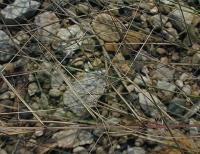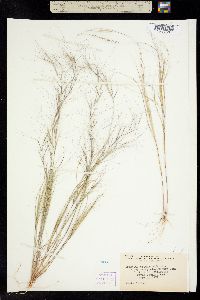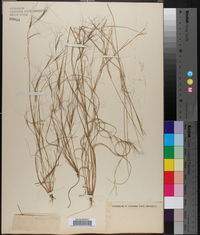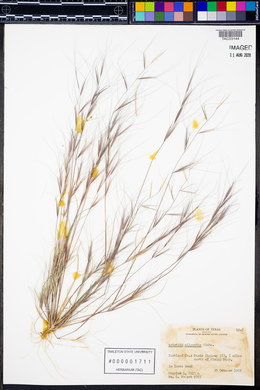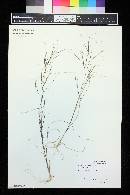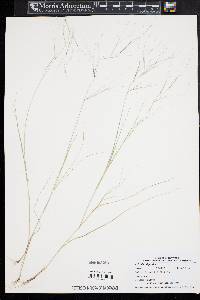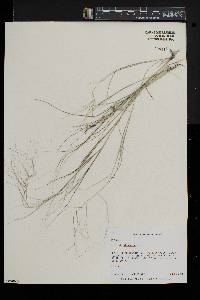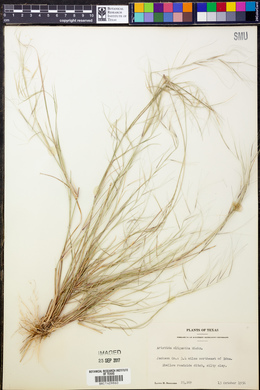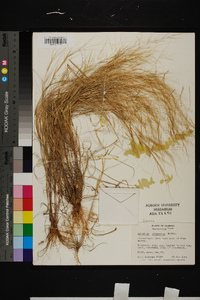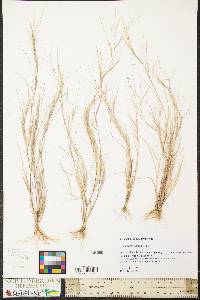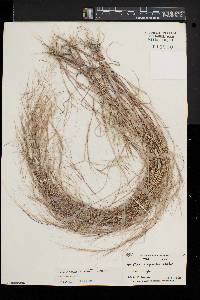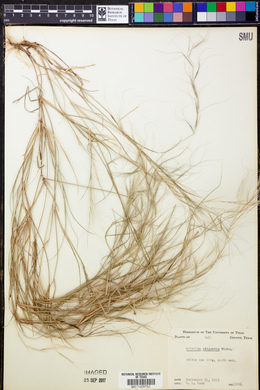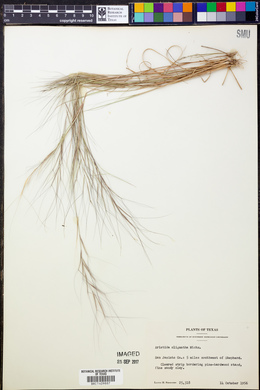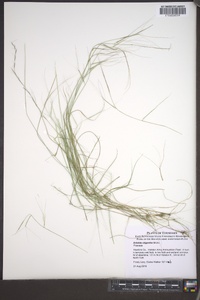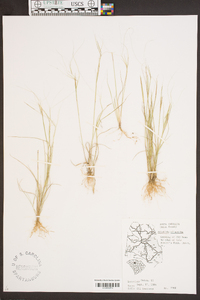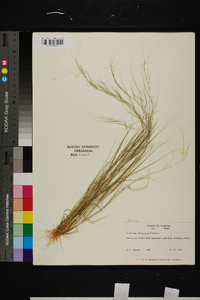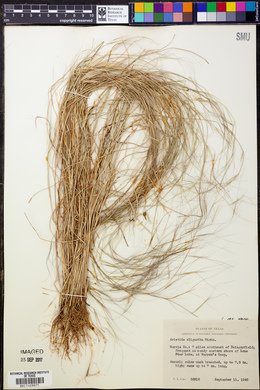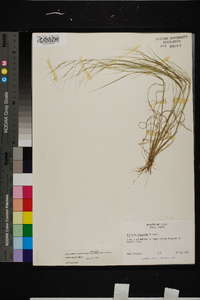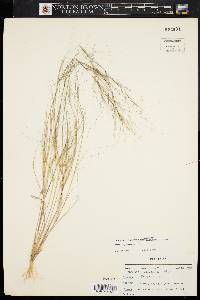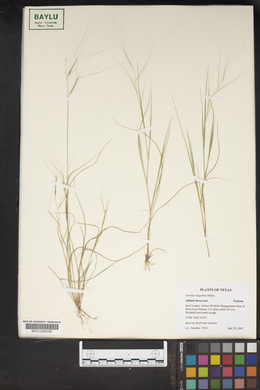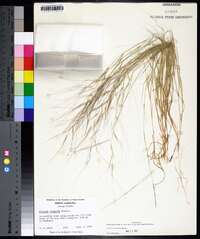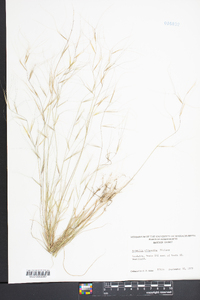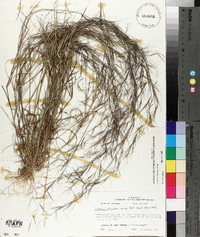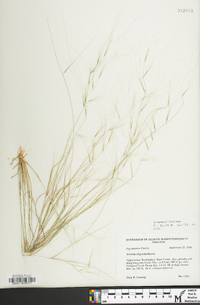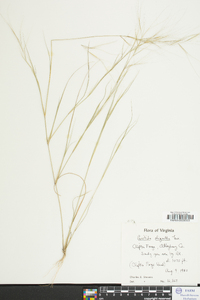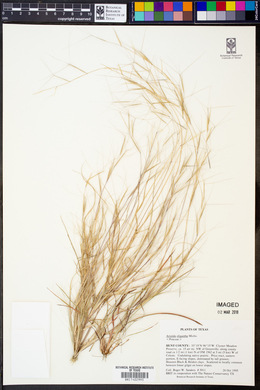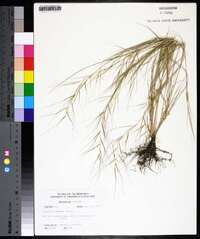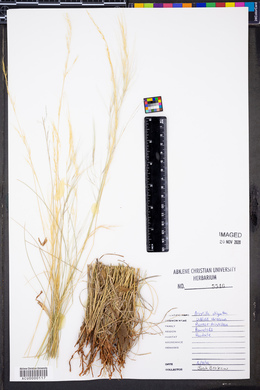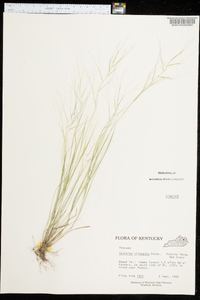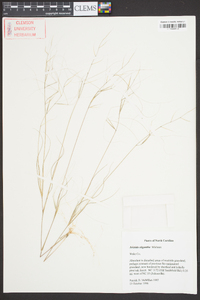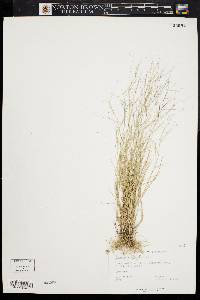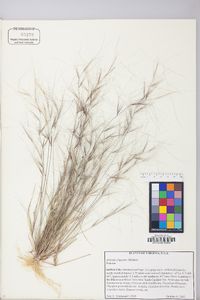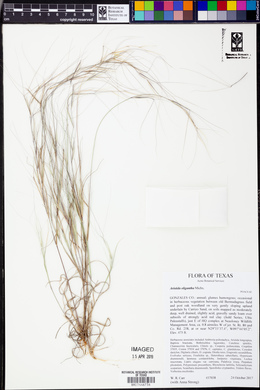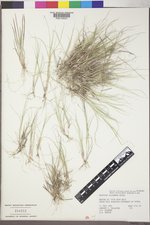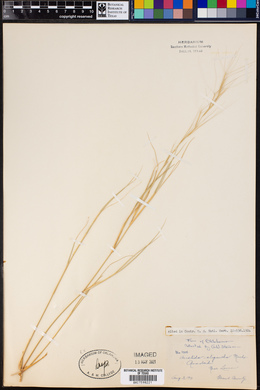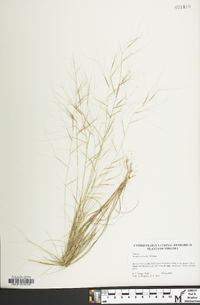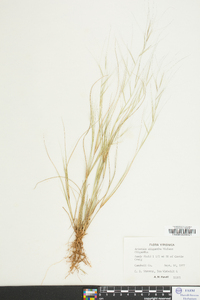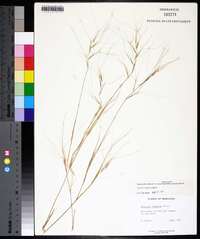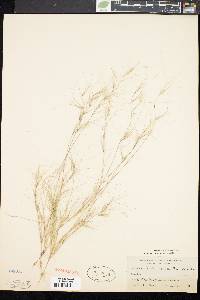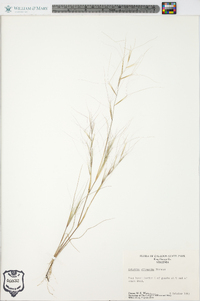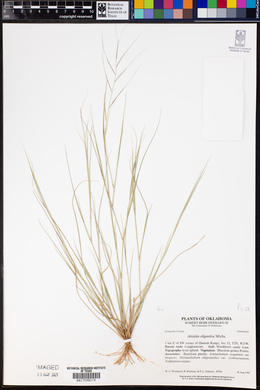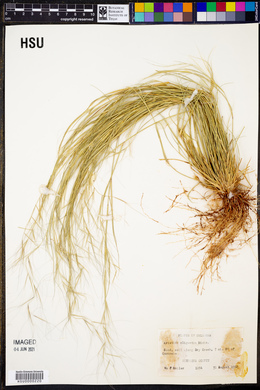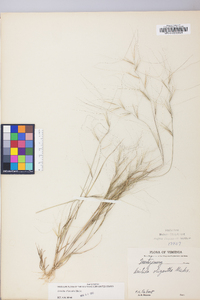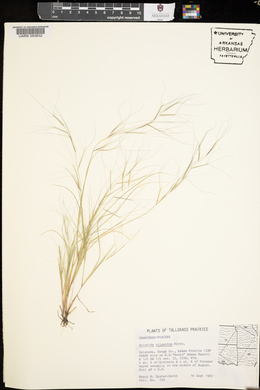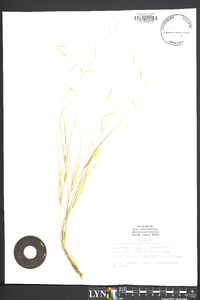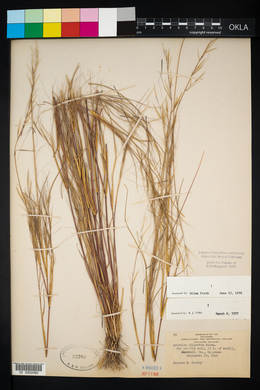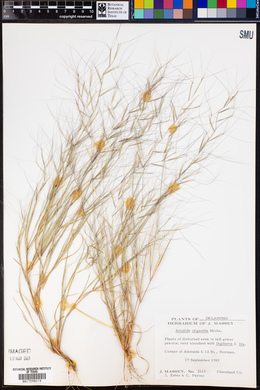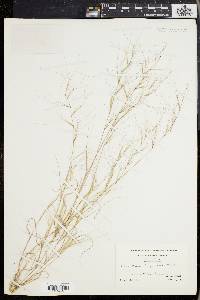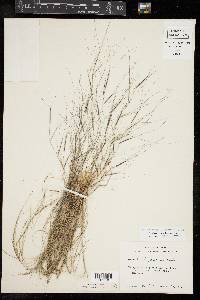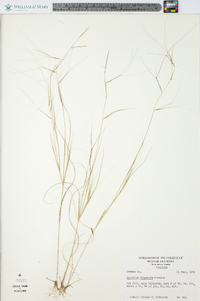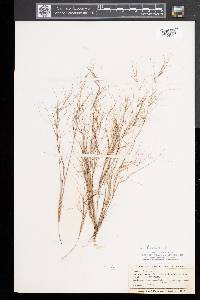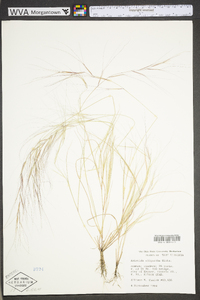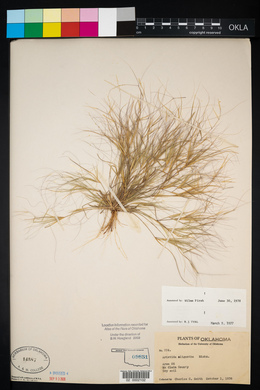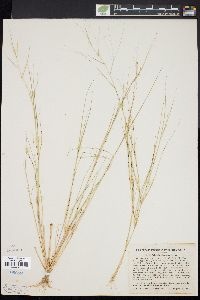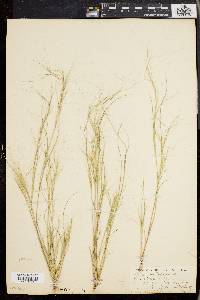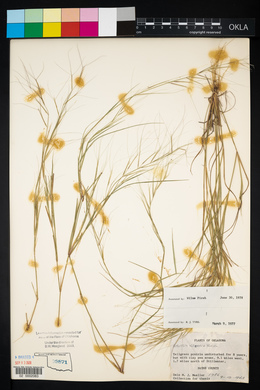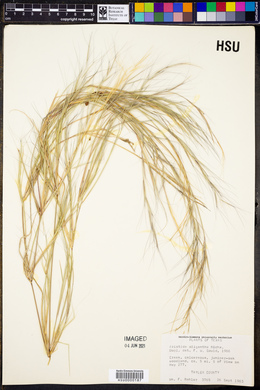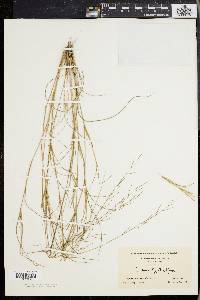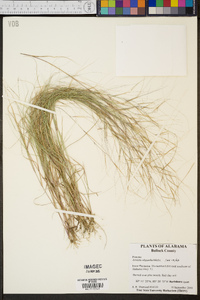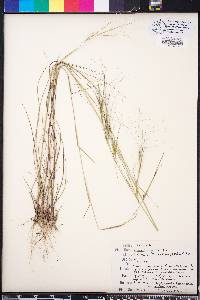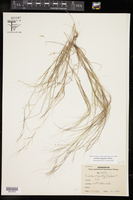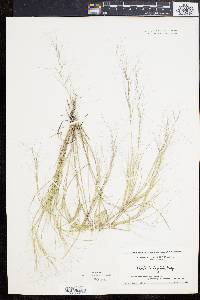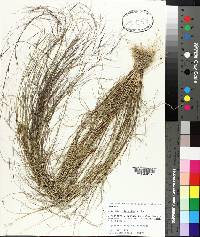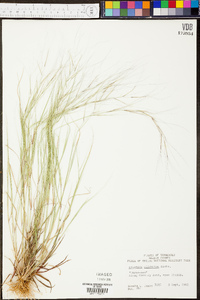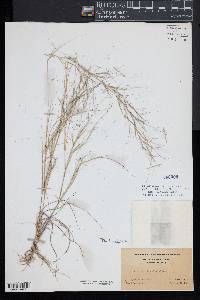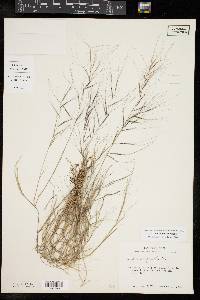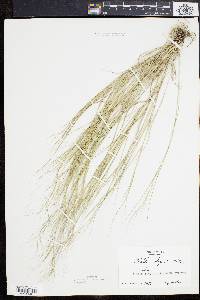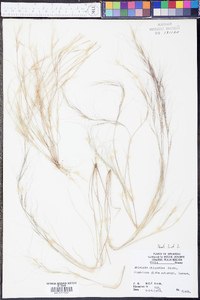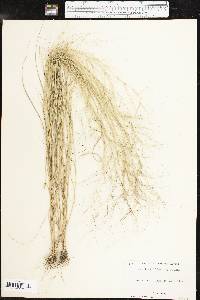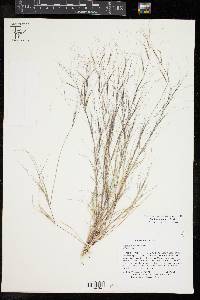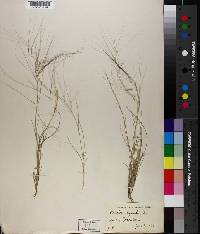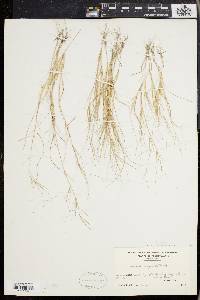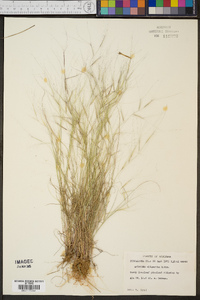
|
|
|
|
Family: Poaceae
Prairie Three-Awn, more...Chase threeawn, Oldfield (Prairie) 3-awn, oldfield threeawn, prairie threeawn
[Aristida macrochaeta Steud., moreAristida micropoda Trin. & Rupr., Aristida oligantha var. nervata Beal, Aristida pauciflora Buckley, Aristida ramosissima var. chaseana Henr.] |
Plants annual. Culm 25-55 cm, erect or geniculate at the base, highly branched. Leaves cauline; sheaths usually shorter than the internodes, lowermost sheaths appressed-pilose basally; collars glabrous; ligules less than 0.5 mm; blades usually 4-12 cm long, 0.5-1.5 mm wide, flat or loosely involute, somewhat lax, glabrous or scabridulous, pale green. Inflorescences spicate or racemose, (5)7-20 cm long, 2-4 cm wide; primary branches rarely developed. Spikelets divergent, pedicels with axillary pulvini. Glumes unequal, glabrous, brownish-green with a purple tinge; lower glumes (9)12-22(28) mm, 3-7-veined, midvein extended into a 1-13 mm awn between 2 delicate setae; upper glumes (7)11-20(24) mm, 1-veined; calluses 0.5-2 mm; lemmas (9)12-22(23) mm, glabrous, light-colored, often mottled; awns subequal, (8)12-65(70) mm, spreading; anthers usually 1 and less than 0.5 mm, rarely 3 and 3-4 mm. Caryopses 8-14 mm, brown. 2n = 22. Aristida oligantha grows in waste places, dry fields, roadsides, along railroads, and in burned areas, usually in sandy soil. It has been reported from Coahuila, Mexico, but is otherwise unknown outside southern Canada and the United States. Annual herb 25 cm - 0.75 m tall Leaves: borne along the culm, having open sheaths usually shorter than the internodes with hairless collars and the lowermost sheaths appressed-hairy at the base. The ligules are made of hairs less than 0.5 mm long, and the pale green blades are 4 - 12 cm long, 0.5 - 1.5 mm wide, flat or with the margins loosely rolling toward the upper surface of the midvein (involute), and hairless or minutely rough. Inflorescence: terminal, 5 - 20 cm long, 2 - 4 cm wide. Fruit: a brown caryopsis, 8 - 14 mm long, spindle-shaped, with a linear scar. Culm: erect or bent at the lower nodes (geniculate), 25 cm - 0.55 m long, highly branched. Spikelets: divergent. Glumes: unequal, brownish green with hint of purple, thin, hairless. The lower glume is 9 - 28 mm long, three- to seven-veined, with a 1 - 13 mm long awn located between two bristles. The upper glumes 7 - 24 mm long and single-veined. Florets: one per spikelet, usually with a single anther less than 0.5 mm long (rarely three anthers 3 - 4 mm long). Lemma: light-colored, usually mottled, 0.9 - 2.3 cm long, spindle-shaped, rolled up longitudinally (convolute), three-veined, hairless, with three nearly equal and spreading awns 0.8 - 7 cm long. Palea: shorter than the lemma, two-veined. Similar species: The other species of Aristida that grow in the Chicago Region have much shorter awns than Aristida oligantha. Flowering: August Habitat and ecology: This species is may be introduced. It is found in disturbed sandy soil and is common in railroad cinder ballast. Occurence in the Chicago region: native Etymology: Aristida comes from the Latin word arista, meaning awn. Oligantha means few-flowered. Author: The Morton Arboretum FNA 2007, Gould 1980 Common Name: prairie threeawn Duration: Annual Nativity: Native Lifeform: Graminoid General: Annual, with stems 25-55 cm, erect or geniculate at the base, highly branched. Vegetative: Leaves cauline, sheaths shorter than internodes, lowermost sheaths appressed-pilose basally, glabrous collars, ligules less than 0.5 mm; blades usually 4-12 cm long, 0.5-1.5 mm wide, flat or loosely involute, somewhat lax, glabrous or minutely roughened, Inflorescence: Spicate or racemose, 7-20 cm long, 2-4 cm wide, primary branches rarely developed, spikelets divergent, pedicels with axillary pulvini; glumes unequal, glabrous, brownish-green with purple tinge; lower glumes 12-22 mm, 3-7 veined, midvein extended into a 1-13 mm awn between 2 delicate setae; upper glumes 11-20 mm, 1-veined; lemmas 12-22 mm, glabrous, light-colored, often mottled; subequal awns, 12-65 mm, spreading. Ecology: Often found in disturbed sites, along roadsides, or in open forest and even burned areas, often in sandy soil from 5,000-7,500 ft (1524-2286 m); flowers August-October. Notes: This plant has been found mostly in the Ponderosa belt, often associated with disturbance, Gould 1980 suggested that it was introduced and only could be found in such habitats. This species is worth a collection, as its distribution is poorly understood. Ethnobotany: Unknown Etymology: Aristida is from the Latin arista for awn, while oligantha means producing few flowers. Synonyms: Aristida ramosissima var. chaseana Editor: SBuckley, 2010 Annual 2-4 dm, branched from the base and usually from all the nodes; lvs 1 mm wide, flat or involute, tapering to a filiform point; terminal panicle 1-2 dm, very lax, few-fld, the lower spikelets usually paired, the upper solitary; lateral panicles few-fld, dense, with short internodes; first glume 3- or 5-veined, scabrous on the keel, 12-29 mm, the second 1-nerved, glabrous, slightly longer; lemma 10-18 mm; awns about equally divergent, 4-7 cm; 2n=22. Dry open ground; Mass. and N.J., where probably intr., to Fla. and Tex.; abundant in the interior, from Ky. and O. to Mich., S.D., and Tex., and adventive in s. Ont. Gleason, Henry A. & Cronquist, Arthur J. 1991. Manual of vascular plants of northeastern United States and adjacent Canada. lxxv + 910 pp. ©The New York Botanical Garden. All rights reserved. Used by permission. From Flora of Indiana (1940) by Charles C. Deam Like the other species of the genus, this species is partial to a slightly acid soil and is infrequent to frequent in the southern half of the state where its habitat is found. It is usually found in hard, white clay soil in abandoned and fallow fields, on washed slopes, along clayey roadsides, and locally in sandy soil in the northern counties. Indiana Coefficient of Conservatism: C = 2 Wetland Indicator Status: n/a |
|
|
|

